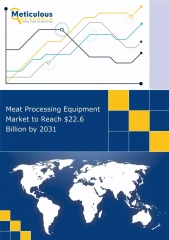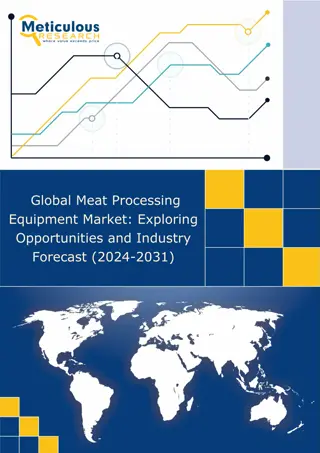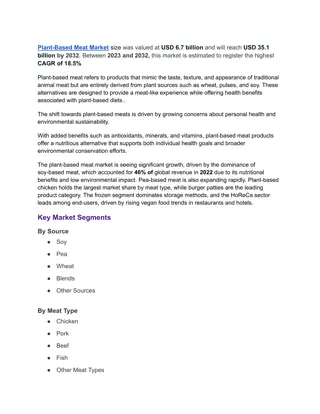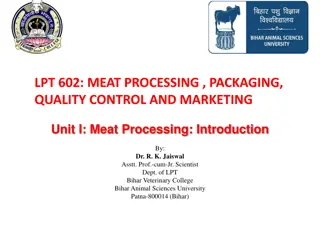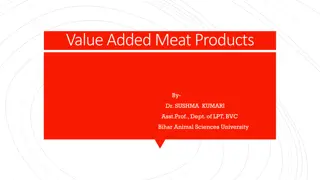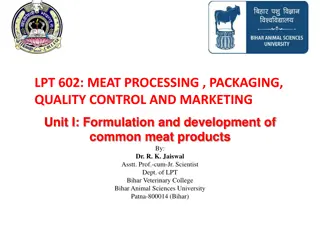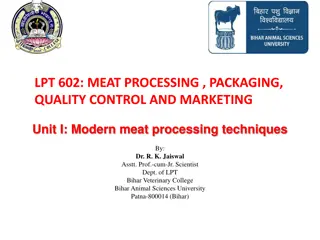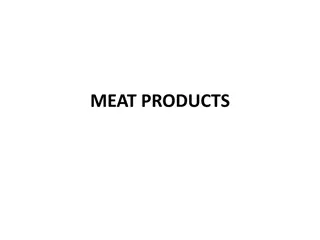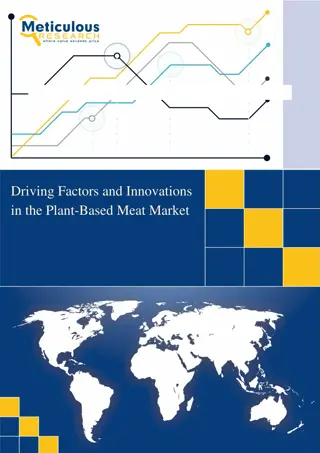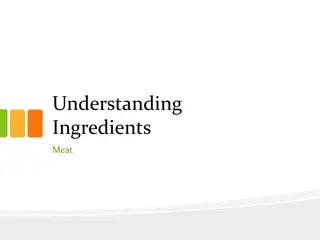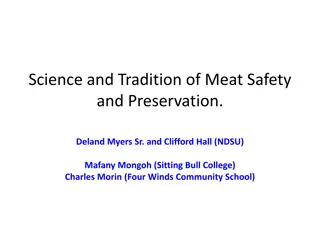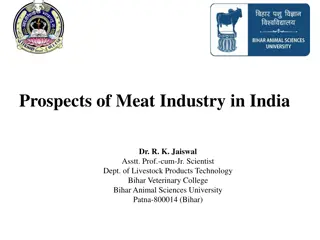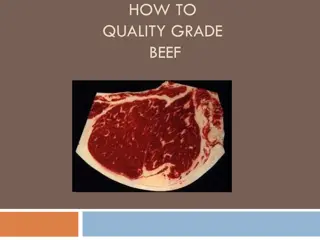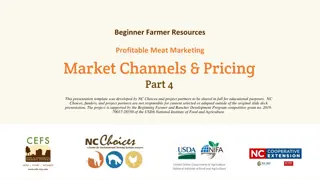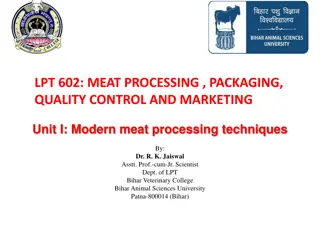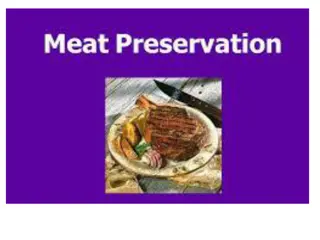Understanding Meat Processing Techniques and Procedures
This article discusses the processing of meat and meat products, including basic and advanced procedures such as comminution, emulsification, and curing. It delves into the importance of size reduction, emulsions, and stable meat emulsions in enhancing the quality and characteristics of meat products. The process involves various stages like hot processing, fermentation, and cooking, highlighting the significance of maintaining low temperatures for creating stable meat emulsions.
Download Presentation

Please find below an Image/Link to download the presentation.
The content on the website is provided AS IS for your information and personal use only. It may not be sold, licensed, or shared on other websites without obtaining consent from the author. Download presentation by click this link. If you encounter any issues during the download, it is possible that the publisher has removed the file from their server.
E N D
Presentation Transcript
Processing of Meat and Meat Products-I Dr. Gargi Mahapatra Asst. Prof. cum Jnr. Sc. Dept. of Livestock Products Technology Bihar Veterinary College BASU, Patna
Processing Any substantial physical and chemical changes in the natural state of meat. treatment which brings about a
Basic Processing Procedures Comminution Emulsification Meat Extension Pre-blending Hot Processing Fermentation Cooking
Advanced Processing Procedures Smoking Curing/ Salting Canning Restructuring
Comminution (size reduction) Reduction of raw meat into smaller pieces or particles. Size reduction improves uniformity and promotes uniform distribution of ingredients.. Instrument: Knives and Meat Mincer
A mixture of two immiscible liquids where one liquid is dispersed in droplets. Phases remain immiscible due to the interfacial tension between them. Stabilized by agents which reduce the interfacial tension. Diameter of dispersed fat droplets in a true emulsion ranges from 1-5 micrometer. Emulsion (continuous phase + dispersed phase) another as existence of emulsifying
Meat Emulsion Dispersed Phase solid or liquid fat droplets + Continuous Phase water containing salt and proteins
Meat Emulsion cont. Meat emulsion is an oil-in water emulsion. A multiphase system. The continuous phase consists of water, salt and proteins hence referred to as matrix, in which fat droplets are dispersed. Fat droplets are usually >50 m and remain coated with soluble proteins (myofibrillar or sarcoplasmic). Low temperature maintained during emulsion formation. Stable meat emulsion: Each fat droplet is coated with a thin layer of soluble protein which has been released into the aqueous medium from the muscle fibres.
Meat Emulsion cont. For meat emulsion meat samples having high myofibrillar content and minimal connective tissue are selected. The process of emulsification is carried in a bowl chopper. The entire process is carried out at low temperatures ranging from 3-13 C, this achieved by addition of chilled water or ice-flakes. Salt is added @ 4-4.5% of the lean meat and the chopping is initiated by keeping the temperature below 3 C. Excessive physical handling and long holding of the emulsion should be avoided.
Process of adding extenders to a meat product. Meat extenders are non-meat substances with substantial protein content. They increase bulk as well modify the nutritional quality of the end product. Increases the Fe and Vit. B content of the product. Reduces the price of the final product, making it affordable to larger masses. Meat Extension
Preblending Mixing of ingredients with ground meat in fixed proportions. This process allows better extraction of proteins which in turn stabilizes the emulsion. It also helps in achieving the desired fat content of the final product.
Hot-Processing & Hot-Boning Earlier hot processing have been defined as processing of meat prior to the onset of rigor mortis. However, the term hot processing is defined as the processing of meat prior to chilling . Whereas removal of bones from fresh meat is known as hot-boning.
Hot-Processing Advantages 1. Reduced cooler space. 2. Reduced labor requirements, energy consumption and in-plant holding time. 3. Superior binding qualities 4. Reduced shrinkage. 5. Increased rendering efficiency. Problems Associated 1. Unavailability of inadequate chilling systems. 2. Inadequate tenderness of the end product. 3. Cut distortion, can be over- come by electric stimulation. 4. Unavailability of adequate packaging systems
Fermentation Eg. Sucuk, Hungarian salami and Chorizo A method of preparing and preserving meat. The bacteria, Lactobacillus, Staphylococcus and Micrococcus, play the most important role in this well known microbial process. Additionally, certain types of yeasts and molds are also used in production of some special fermented meat products. The process leads to development of organic acids(eg. lactic acid)
Improved organoleptic properties viz. appearance, color, flavor, aroma, taste texture and juiciness. Enhanced nutritive value and digestibility. Maintains keeping quality of the meat product by inhibiting the growth of food pathogens and spoilage organism by producing bacteriocins. Fermentation Advantages
Cooking Dry Heat Moist Heat Microwave Cooking
Dry Heat Cooking Implied for tender cuts and comminuted meats. Types: Broiling; Roasting and Frying. Broiling: Meat held on a wire grill, is exposed to heat from above . Meat turned around for uniform cooking. Roasting: Roast pieces at least 8 cm thick, placed fat side up and placed in a hot air oven at 115-150 C. Imparts brown color to the end product and enhances flavor of the product. Frying: Heating in pan with deep or shallow fat, suitable for thin cuts.
Moist Heat Cooking Implied for relatively tough cuts of meat. Types: Pressure Cooking; Stewing; Simmering and Braising. Pressure Cooking: Meat cooked under high pressure and temperature. Facilitates the tenderization of tough cuts. Stewing: Meat pieces are first browned in small amount of fat and then covered with water/curry stuff and simmered, while covering the container. Final product becomes tender with the curry
Moist Heat Cooking cont. Simmering: Cooking in hot water at 70 C for considerable amounts of time. Braising: It utilizes both dry heat as well as moist heat. The meat cuts are first fried and then put in a covered container along with water and seasoning, then cooked at 80-90 C.
Microwave Cooking Relatively recent development. Microwaves: High frequency, non-ionizing electromagnetic waves which are reflected by metals. Microwaves penetrate the food from all directions up to a depth of 2-4 cm causing water, fat and sugar molecules to vibrate at very high speeds. Vibration of molecules causes friction which in turn produce heat. Causes volume heating i.e. the heat in food spreads through three dimensional space. No browning achieved and for uniform food needs to be turned frequently.


